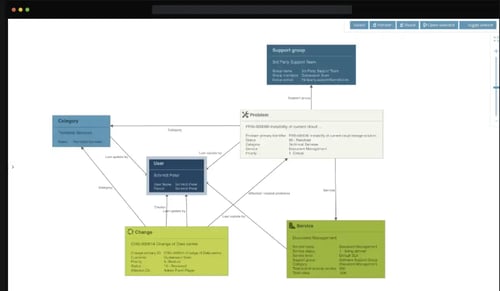What is a Configuration Management Database (CMDB)?
A Configuration Management Database (CMDB) is a centralized repository that stores detailed information about Configuration Items (CIs) and their relationships. CIs can include IT assets—such as hardware, software, and network devices—as well as other components essential to delivering and supporting business services.
Table of Contents:
Introduction to the Configuration Management Database
A Configuration Management Database (CMDB) is a centralized repository that stores detailed information about an organization’s IT assets, also known as Configuration Items (CIs), and their relationships. These CIs include hardware (like servers or routers), software, network devices, and other IT components critical to delivering business services.
In the ITIL framework, the Configuration Management Database (CMDB) is a key component of the broader Configuration Management System (CMS). A CMS may consist of multiple databases, all working together to manage configuration items. The primary goal of the CMS and CMDBs is to store detailed information about these configuration items, which are managed under the control of the Asset and Configuration Management practice. This ITIL practice aims to maintain accurate information about configuration items and their relationships, ensuring effective delivery of IT services.

The CMDB acts as the backbone of IT service management (ITSM), enabling organizations to track the state and relationships of all assets in real-time. This visibility is crucial for streamlining IT operations, managing risks, and improving decision-making processes.
What is the Purpose of a CMDB?
A CMDB offers a bird’s-eye view of complex IT ecosystems. It helps organizations understand the relationships between CIs, their dependencies, and how changes to one component might affect the rest of the system. Key purposes include:
- Impact Analysis: Predict the outcomes of IT changes to mitigate service disruptions based on data in the CMDB.
- Root Cause Analysis: Identify the source of incidents or problems by tracing connected components.
- Compliance Management: Maintain well-documented records of IT assets for audits and regulatory compliance.
- Decision Optimization: Use real-time data for better asset management, budgeting, and long-term planning.
- Incident and Problem Resolution: Accelerate response times by linking incidents to related CIs.
Ultimately, a properly implemented CMDB minimizes service downtimes and maximizes operational efficiency.
Terminology
| Term | Description |
|---|---|
CMDB |
A Configuration Management Database (CMDB) is a centralized repository used to store information about Configuration Items (CIs), including their attributes and relationships. It supports IT service management by providing visibility into the components that make up IT services, including hardware, software, documentation, and more. |
Configuration Item (CI) |
A Configuration Item (CI) is any component that needs to be managed in order to deliver an IT service. This can include hardware, software, documentation, services, or any other element relevant to IT operations. Each CI includes descriptive information (attributes) and details about its relationships with other CIs in the IT environment. |
Service Asset and Configuration Management |
The ITIL practice focused on managing information about Configuration Items (CIs) essential for delivering IT services. This includes maintaining details about their attributes and relationships. |
Configuration Management System (CMS) |
A suite of integrated tools and databases designed to manage configuration items (CIs) while offering a clear, comprehensive view of their relationships and statuses throughout the organization. |
IT Asset Management |
The process of managing an organization's IT assets aims to enhance efficiency, reduce costs, and ensure compliance throughout the entire IT asset lifecycle. |
Software Asset Management |
A specialized area of IT Asset Management (ITAM) dedicated to efficiently managing and optimizing the procurement, deployment, usage, and tracking of software licenses within an organization. |
ITIL |
The IT Infrastructure Library (ITIL) is a comprehensive framework of best practices designed to enhance the efficient and effective delivery of IT services. It offers detailed guidance on processes such as Service Asset and Configuration Management (SACM), enabling organizations to optimize their IT operations. |
Benefits
Improved service delivery
Enhanced incident and problem management
Effective change management
Strategic decision-making support
Regulatory compliance and risk reduction
IT Asset Management, Configuration Management, and their Relation to the CMDB
The CMDB is closely linked to IT Asset Management, Software Asset Management and Configuration Management as these processes are concerned with managing assets in the company IT ecosystem. The following table summarizes the differences between each.
| Process | Configuration Management | IT Asset Management | Software Asset Management |
|---|---|---|---|
| Primary Focus | Managing the relationships and dependencies of IT services and components. | Managing the physical, financial, and contractual aspects of IT assets. | Managing software licenses, compliance, and usage within an organization. |
| Objective | To ensure assets and services are accurately represented and consistently configured to efficiently support business processes. | Optimize IT assets, reduce costs, and ensure compliance with financial and regulatory standards. | Manage software licenses, optimize spending, and ensure compliance with regulations. |
| Scope | Covers various IT components like software, hardware, and network systems essential for service delivery. | Focused on managing the entire lifecycle of IT hardware assets, from procurement to maintenance and disposal. | Managing software assets throughout their lifecycle, including procurement, licensing, and retirement. |
| Activities Involved | Configuration identification, control, status accounting, and verification/audit. | Asset procurement, deployment, discovery, maintenance, and disposal or reassignment. | License procurement, compliance auditing, utilization tracking, and renewal management. |
| Examples of Items | Servers, Virtual machines, Software applications/systems, Databases, Clusters, Networks | Workstations, Mobile devices, Monitors, Servers, Network devices, Printers | Software licenses, Software license pools, Software license contracts |
| Data Tracked | Details about configuration items (CIs) such as versions, components, and their relationships. | Details on an asset's location, user, condition, purchase, cost, depreciation, and disposal. | Software licenses, purchase contracts, usage data, compliance status, renewal dates, and costs. |
| Compliance and Reporting | Ensures IT components and services meet defined configurations for efficiency. | Ensures assets are managed and utilized in strict adherence to company policies and legal regulations. | Ensure that software usage adheres to licensing agreements and complies with all legal regulations. |
| Value to Business | Enhances service delivery, reduces downtime, and supports effective change management. | Optimizes asset costs, improves asset utilization, and supports financial and compliance reporting. | Control software costs, avoid legal risks, and optimize software investments and usage. |
CM, ITAM and SAM are separate processes with commonalities and some overlap. The CM process typically manages many IT Assets managed by the ITAM and SAM processes to ensure the relationships and dependencies related to service delivery are known and to ensure that the CIs are available and operational.
The term Configuration Management Database (CMDB) is common in the context of the aforementioned processes. The CMDB can be seen as an outcome of the Configuration Management Process and, as a concept, should not be confused with the IT Asset Management process. However, from a technical perspective, the IT Assets are stored as CIs in the CMDB.


Unlock Efficiency: Getting Started with AI in Service Management
February 10, 2025

7 Tips for Navigating Complexity in IT Asset Management
July 03, 2024
Best practices
Follow these best practices to maximize the effectiveness of your CMDB:
- Define Goals and Scope
Start by clearly defining the objectives of your CMDB and the specific processes it will support, such as improving incident resolution, tracking compliance, or enabling better change management. Identify the key use cases to ensure that your CMDB delivers measurable value to the organization. Involve relevant business units and stakeholders in defining and categorizing services, ensuring alignment with organizational priorities and creating a shared understanding of expected outcomes.
- Integrate with other systems and Automate Data Discovery
Seamlessly connect your CMDB with ITSM tools, asset management systems, and other key platforms to create a unified ecosystem. This integration enhances operational efficiency, provides a single source of truth, and ensures consistent data across systems. Leverage automated discovery tools to identify configuration items (CIs) across your IT environment and keep them up to date. Automation reduces manual errors, saves time, and improves data accuracy, ensuring that your CMDB remains reliable and comprehensive.
- Assign Ownership and Perform Audits
Designate clear ownership for the accuracy and maintenance of CI data to specific individuals or teams. These owners are responsible for ensuring data consistency, addressing discrepancies, and implementing updates when needed. Additionally, conduct regular audits of your CMDB to assess data reliability, uncover gaps, and verify that the information accurately reflects the current state of your IT environment. These audits help maintain confidence in the CMDB and highlight areas for improvement.
- Map Relationships and Monitor Continuously
Document the interdependencies and relationships between CIs to provide a deeper understanding of your IT environment. Use visualization tools to create clear, interactive maps that reveal how various components interact and impact each other. Incorporate real-time monitoring and updates to ensure your CMDB stays current as changes occur. Continuous monitoring helps you proactively identify issues, improve decision-making, and maintain a dynamic, accurate view of your infrastructure.
